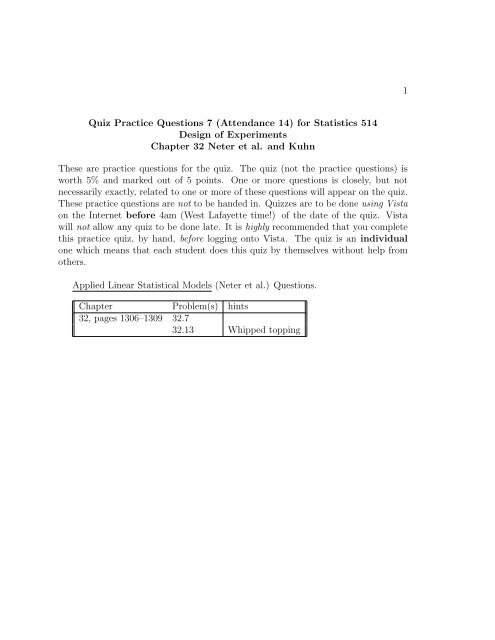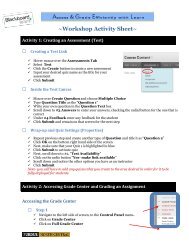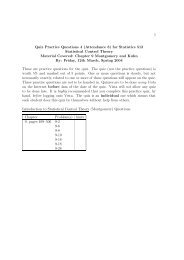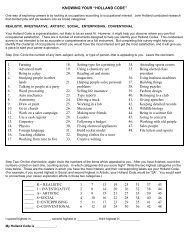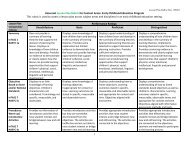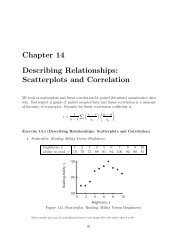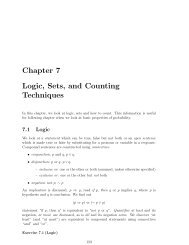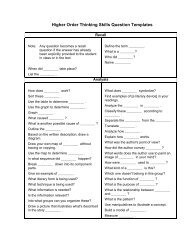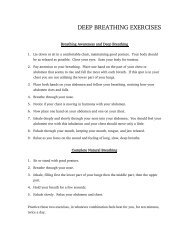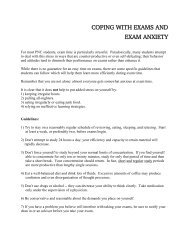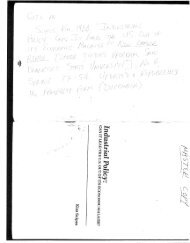1 Quiz Practice Questions 7 (Attendance 14) for Statistics 514 ...
1 Quiz Practice Questions 7 (Attendance 14) for Statistics 514 ...
1 Quiz Practice Questions 7 (Attendance 14) for Statistics 514 ...
Create successful ePaper yourself
Turn your PDF publications into a flip-book with our unique Google optimized e-Paper software.
1<strong>Quiz</strong> <strong>Practice</strong> <strong>Questions</strong> 7 (<strong>Attendance</strong> <strong>14</strong>) <strong>for</strong> <strong>Statistics</strong> 5<strong>14</strong>Design of ExperimentsChapter 32 Neter et al. and KuhnThese are practice questions <strong>for</strong> the quiz. The quiz (not the practice questions) isworth 5% and marked out of 5 points. One or more questions is closely, but notnecessarily exactly, related to one or more of these questions will appear on the quiz.These practice questions are not to be handed in. <strong>Quiz</strong>zes are to be done using Vistaon the Internet be<strong>for</strong>e 4am (West Lafayette time!) of the date of the quiz. Vistawill not allow any quiz to be done late. It is highly recommended that you completethis practice quiz, by hand, be<strong>for</strong>e logging onto Vista. The quiz is an individualone which means that each student does this quiz by themselves without help fromothers.Applied Linear Statistical Models (Neter et al.) <strong>Questions</strong>.Chapter Problem(s) hints32, pages 1306–1309 32.732.13 Whipped topping
<strong>Practice</strong> <strong>Quiz</strong> <strong>Questions</strong> 7 (<strong>Attendance</strong> <strong>14</strong>), 32.7, pp 1306–1309 2(32.7) Five–factor response surface(a) Number of regression coefficientsThe response function is given byY i = β 0 X 0 + β 1 X i1 + β 2 X i2 + β 3 X i3 + β 4 X i4 + β 5 X i5+ β 11 Xi1 2 + β 22 Xi2 2 + β 33 Xi3 2 + β 44 Xi4 2 + β 55 Xi52+ β 12 X i1 X i2 + β 13 X i1 X i3 + β <strong>14</strong> X i1 X i4 + β 15 X i1 X i5+ β 23 X i2 X i3 + β 24 X i2 X i4 + β 25 X i2 X i5+ β 34 X i3 X i4 + β 35 X i3 X i5 + β 45 X i4 X i5 + ε ijkand so there are ? regression coefficients.(b) Linear, quadratic and two–factor terms?There are? linear main effects? quadratic main effects? two–factor effects(c) Number of design pointsNeed at least 21 design points to estimate the 21 regression coefficients.Need at least ? design points <strong>for</strong> a five–factor central composite designthat is based on a 2 5−1V fractional factorial design becausen T = 2 k−f n c + 2kc s + n 0 = ?where there are n c = c s = n 0 = 1 replications at the corner points, starpoints and center points, respectively.
<strong>Practice</strong> <strong>Quiz</strong> <strong>Questions</strong> 7 (<strong>Attendance</strong> <strong>14</strong>), 32.13, pp 1306–1309 3(32.13) Whipped topping: qz7-32-13-topping-response(a) Two–factor rotatable central composite designThe second–order response function isY i = β 0 X 0 + β 1 X i1 + β 2 X i2 + β 12 X i1 X i2+ β 11 Xi1 2 + β 22 Xi2 2 + ε ijkwhere, from SAS, the estimated coefficients arecoefficient b q p–valueb 0 189.75 < 0.0001b 1 28.247 0.0008b 2 -0.772 0.87b 12 ? 0.0748b 11 -18.128 0.0115b 22 -6.875 0.223It looks like an appropriate hierarchical model would beY i = β 0 X 0 + β 1 X i1 + β 11 X 2 i1 + ε ijksince b 1 is significant (active), but b 2 is not significant.(b) ResidualsLook at the SAS output.
<strong>Practice</strong> <strong>Quiz</strong> <strong>Questions</strong> 7 (<strong>Attendance</strong> <strong>14</strong>), 32.13, pp 1306–1309 4(c) Lack of fit testFrom SAS, the ANOVA table isSource Sum Of Squares Degrees of Freedom Mean SquaresRegression 9316.05569 5 1863.21<strong>14</strong>Error 978.860975 6 163.<strong>14</strong>35Lack of Fit ? 3 ?Pure Error ? 3 ?Total 10295 11H 0 : µ = β 0 X 0 + β 1 X i1 + β 2 X i2 + β 12 X i1 X i2 + β 11 Xi1 2 + β 22 Xi2 2 versusH a : µ ≠ β 0 X 0 + β 1 X i1 + β 2 X i2 + β 12 X i1 X i2 + β 11 Xi1 2 + β 22 Xi22(In other words, H o : no lack of fit versus H a : lack of fit)The test statistic isF ∗ =SSE − SSPEdf E − df P E÷ SSPEdf P E= SSLFdf LF= ? 3 ÷ ? 3= 3.24÷ SSPEdf P EThe critical value is F (1 − α; df LF , df P E ) = F (0.99; 3, 3) = 29.5since F ∗ = 3.84 < F = 29.5accept null; that is, there is not lack of fit(In other words, the model appears to be a good one.)(d) Three–dimensional plot and contour plot <strong>for</strong> response surfaceLook at the SAS output.(e) Calculation of maximum <strong>for</strong> the response surfaceB =[−18.128 13.75/213.75/2 −6.875], b ∗ =[28.247−0.772]and soX s = − 1 [?2 B−1 b ∗ =?]
<strong>Practice</strong> <strong>Quiz</strong> <strong>Questions</strong> 7 (<strong>Attendance</strong> <strong>14</strong>), 32.13, pp 1306–1309 5(f) Confidence interval <strong>for</strong> mean responseFrom SAS,Ŷ h = ?s{Ŷh} = 13.70t(1 − α/2; n − p) = t(1 − 0.05/2; 12 − 6) = 2.447and so the 95% confidence interval isŶ h ± t(1 − α/2; n − p)s{Ŷh} = ? ± 13.70(2.447) = (173.1, 240.1)


